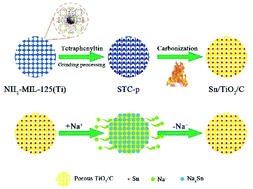Abstract
Sn-Based materials are attracting increasing attention for application in sodium-ion batteries (SIBs), due to the ultra-high theoretical capacity of pure Sn. However, low structural stability and poor rate capability restrict their further development. Herein, a facile method is reported to embed Sn nanocrystals into a TiO2/porous carbon (TiO2/C) composite by direct carbonization of a mixture of tetraphenyltin and a Ti-based metal–organic framework. The obtained cylinder-like Sn/TiO2/porous carbon (Sn/TiO2/C) composite is uniformly built from TiO2 nanoparticles, Sn nanocrystals and N-doped carbon. Importantly, pores, formed by the accumulation of nanoparticles, can effectively restrict the huge volume change of Sn during cycling. When evaluated as an anode in SIBs, the Sn/TiO2/C composite not only possessed amazing cycling stability (159.6 mA h g−1 at 1.0 A g−1 after 3000 cycles), but also exhibited excellent rate performance (172.3 mA h g−1 at 1.0 A g−1 and 114.0 mA h g−1 at 10.0 A g−1). These superior properties can be attributed to Sn nanocrystals which enhanced specific capacity and electrical conductivity, and the TiO2/C substrate which improved structural stability, facilitating charge transfer kinetics.

- This article is part of the themed collection: 2019 Inorganic Chemistry Frontiers HOT articles


 Please wait while we load your content...
Please wait while we load your content...